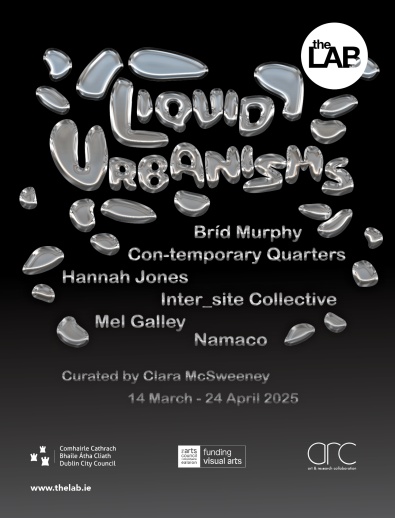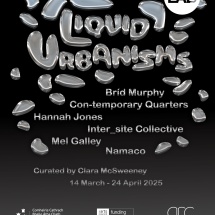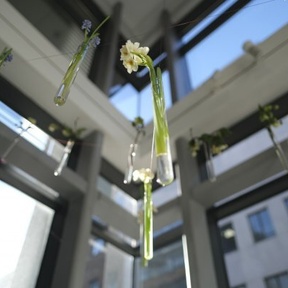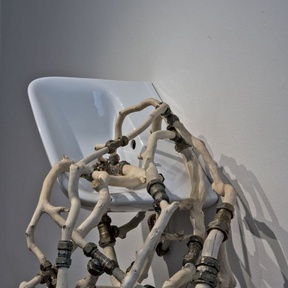Liquid Urbanims
Dé hAoine 14 Márta - Déardaoin 24 Aibreán 2025
The LAB Gallery is pleased to present its latest exhibition Liquid Urbanisms curated by ARC – LAB Scholar Clara McSweeney.
This show will run from the 14th of March – 24th of April. An exhibition preview will happen on the 13th of March, 6pm - 8pm.
Liquid Urbanisms is a group show featuring projects by Bríd Murphy, Con: temporary Quarters (Aoife Ward and Eve Woods), Hannah Jones, Inter_site Collective (Pádraic Barrett, Aoife Claffey, Kate McElroy), Mel Galley and Namaco (Han Hogan and Dónal Fullam) This group exhibition focuses on the speculative futures of buildings and dwellings in Ireland in the context of the ongoing housing crisis.
Related Free Events:
29th March: 3pm - 4.30pm
Walkthrough event with the artists and the curator.
13th, 20th, 27th March: 6:45pm to 8:45pm.
Three public viewings of Bríd Murphy’s Semi / Detached II displayed from a window pane on James Joyce Street
Brid Murphy
Bríd Murphy is a Dublin-based visual artist and a graduate of Limerick School of Art & Design. Her practice explores themes of anxiety, identity, and Ireland’s ongoing housing crisis through site-specific video interventions. She was awarded a graduate residency at the National Sculpture Factory and was shortlisted for the Zurich Portrait Prize at the National Gallery of Ireland in 2019. Her work has been exhibited at the National Museum of Ireland, the Cork Film Festival, and GRAFT, a collaborative project by the Glucksman and the National Sculpture Factory.
Semi / Detached II projects two videos onto the upstairs windows of the LAB Gallery. From the street below, viewers witness life-sized figures, cramped together, shifting uncomfortably within the confined space. These projections create a ghostly presence, hinting at lives that could be housed, spaces that could be filled, and the unsettling disconnect between housing need and property neglect in Dublin. The work highlights the absurdity of a city where thousands struggle to afford rent while vacant properties are left to rot.
This installation reflects the reality of many younger generations in Ireland—trapped in a housing system where security and affordability are out of reach. It is a stark reminder of the failures of Irish housing policy and its impact on daily life. Semi / Detached II amplifies this crisis, urging reflection on how space, or the lack of it, shapes identity, well-being, and community.
Con: temporary Quarters
Con: temporary Quarters led by Aoife Ward and Eve Woods brings attention to the use and misuse of space. Céad Míle (Fail)te embodies the infantilisation inherent in housing degradation. With the rentier class subservient to technocratic policies the claustrophobic body horror is communicated through an affronting artifice of intelligence smothering its occupant as it tells a tale of lotteries for coffin homes, the relinquishing of cityspace to corporations and their cooling towers, and compulsory wellness protocols. Utilising sci-fi tropes, housing and policy jargon Con: temporary Quarters continue their scathing critique of the substandard design of our built environment through satirical performance; this time with the help of the patriarchal man-bot who wants you to live with(in) him!
Select actions include: An Couch Pleanala in The Irish Times, WAKE with Arthology Collective, DABF: Fictions – The Makings of Other Worlds, NIVAL Art & Property, Space Now with Outlandish Theatre, The Perennial Affair: An Exploration Between Art and Politics, TCD, 2024, Create Summer School for COLLABORATIVE PRACTICE & SOCIAL CHANGE Practice & Social Change, Des Kelly MOMA, That Social Centre, DABF Polyphonic, CtQ The Exhibition at the demolished Tivoli Theatre, Who is this city built for? Culture Night, Banned as an Ti @ FanVid Dublin, Open House, Derelict site on N. Brunswick St, Softening Corners, Creative Futures Academy, A Culture of Care for The Liberties, RENT, Housing Unlocked Irish Architecture Foundation, Reboot Republic, Generation Locked Out of Home with Rory Hearne, City of Care Roundtable 2023, A Cultural Tour of Hotels in the Liberties, How to Exist in a Public Space 2022.
Hannah Jones
Hannah Jones is a visual artist based in Dublin, Ireland. Her practice uses sculptural installations to explore questions around heritage, placement, and sentiment, focusing on ideas of dwelling and the body’s placement within it. She builds using natural materials, with a focus on cob. Her work also includes seaweed building, copper printing, sound and video projection alongside other digital means.
Under the Rafters looks at our connection to place, using the installation space to question how we affect a space and how a space can influence us, allowing viewers to consider the symbiotic relationship between the emotional being and place.
The forms used within this work, inspired by natural and architectural formations, create a tactile and atmospheric quality to the space they inhabit, inviting viewers to contemplate the connection between place and sensory perception—be it smell, sound, feel, or air quality.
This project uses cob, a traditional building material made of topsoil, clay, sand and hay. The labour needed to create cob is key to the work. It must be mixed by hand as the weight of the material would break machinery. The roof and bricks of this work have been plastered and shaped by hand.
Through her research, she explores how culture, traditional skills and environment contribute to belonging.
She has exhibited in, The Place Project, IMMA Studios, Dublin (2021), Open Studios, Bard College Berlin (2022), Open studios, Monopol, Berlin (2023), In the making: Aorta, Pallas Projects/Studios, Dublin (2024), On Show, Institute of Art Design + Technology Dún Laoghaire, Dublin, (2024), Silver Apples of the Moon / Golden Apples of the Sun, CQS+S, (2025)
She has received awards from, IADT Summer Studios (2024), RDS Visual Art Awards long listing (2024), IADT/ Pallas Projects Mentorship Award, (2024), Fire Station Artists' Studios Graduate Sculpture Residency Award (2024), Superprojects/Clancy Quay Studios Professional Development Programme (2024-25)
Inter_site
inter_site is a multidisciplinary Cork based artist collective established by Pádraic Barrett, Aoife Claffey, Deirdre Breen and Kate McElroy. They graduated together from the MA in Art and Process, Crawford College of Art and Design, MTU, 2021. Since forming they have created seven site responsive exhibitions in Cork, taken part in three international exhibitions and together have undertaken a residency in PADA, Portugal. Their most recent shows include ⌥ertigo, A Crescendo at Cork County Hall and Error: /Undefined, Pallas Projects, Dublin, 2023 which coincided with the launch of a publication documenting their six site responsive exhibitions in Cork.
Pádraic Barrett
Auto-Cannibalism is a provocative exploration of self-exploitation within contemporary capitalist systems, where the body becomes both a site of production and consumption. Barrett examines the psychological and physical toll of neoliberalism, using cannibalistic imagery as a metaphor for self-sacrifice in pursuit of personal or societal goals. Visceral, grotesque imagery in the film depicts self-devouring, embodying a system that perpetuates self-consumption. The installation frames the film with two rows of spikes, evoking a mouth and mirroring the devouring nature of hostile architecture. A reimagined gallery bench, both functional and sculptural, incorporates the same motifs, confronting viewers with discomfort and questioning how urban spaces regulate bodies.
Kate McElroy
Precipice, potentialities is a dynamic constellation of glass sculpture, light, expanded photography, installation and spoken word. This altering environment interrogates the unsustainable nature of our current systems and our place within them. Boundaries between self, surroundings, and structures blur, as the solid becomes liquid and dichotomies dissolve. Challenging static notions of form, the work fosters fluidity and disrupts fixed patterns, opening new possibilities for transformation. Existing in a space between construction and destruction, it highlights a moment of precarity while gesturing towards reconfiguration. At this societal and environmental precipice, this interstitial space exists as a site of criticality and potentiality.
Mel Galley
Adrift, Frances haunts a future city, five years out of time. The fabric of the streets flickers around her as proposed building plans fall in and out of existence, disputed and discarded back in the present. As places suspended between being-and-not waver, it is the loss of a favourite street (where the cathedral tower aligns between the rows of terraces) that shakes her. Where do these places go to when they cease to exist? There is no ruin, just a new site, blanketing over memory. The first model she builds, of this street, is the unintentional centre of her city; a series of places that once were, or almost were, or will be in the future. Lost in time, she asks; how do we choose which places to remember?
‘Valerian’ and ‘Holdings’ were created as part of Data Stories, a four year project mapping the property and planning data ecosystem in Ireland. Over two case studies, Mel worked with researchers Dr Juliette Davret, Dr Danielle Hynes and Dr Sam Mutter to create these 'data stories', questioning how data is being created, held and instrumentalised to shape the places we inhabit. The ERC funded project is based at Maynooth University Social Science Institute, led by Professor Rob Kitchin.
Mel is an artist and writer who looks (mostly) at place, memory and speculative futures. Through narrative and modelmaking, she builds speculative landscapes which hinge on the concept of palimpsests. In 2023, she completed an MA in Art and Research Collaboration at IADT. Her work has been shown across Ireland and the UK, including the LAB Gallery, Barnavave, UCC, and Signal Film & Media. In 2020, she was awarded Young Cumbrian Artist of the Year and won second place in the RIBA Eyeline Awards 2021. Her artworks are held in the collections of the Bodleian Library (Oxford) and, more importantly, on the walls and bookshelves of strangers and friends.
Namaco
“Welcome to GRAND CANAL DEMOLITION DERBY, home to the Free State’s Glittering Silicon Docks. Here you’ll meet your Tech Overlords Meta, Amazon, Apple, X and Google who thrive on profit HYPER-EXTRACTION and the TOTAL OBLITERATION of our communities.”
Grand Canal Demolition Derby, is a PS1-style game set between the spectral netherworld of Saol Eile and the high-stakes arena of Dublin’s Grand Canal Dock.
In Saol Eile we journey through a millennium of economic history, learning the background to Ireland’s dependence on foreign direct investment: From centuries of colonial limitations imposed by Britain, to the wholesale substitution of indigenous Irish industry with US investment from the 1950s onwards.
In Grand Canal Dock Arena we drive between glistening towers of US capital, which cast a shadow over the remnants of working class Dublin. Easter eggs hidden throughout the city— the Eircom phonebox, the Bord Gáis Energy Theatre, and Charles Haughey’s yacht, The Celtic Mist— tell a story of tax avoidance and privatisation. Meanwhile a heated debate crackles on Joe Duffy’s Liveline concerning the 13 billion Euro windfall tax owed to the Irish government by Apple Inc.
The player is prompted to consider the outcome of their actions within or in opposition to tech-billionaire industry. Press ‘X’ to act as an individual - fuelling the free market with deference or loyalty. Press ‘O’ to join the resistance - smashing the mainframes of US capital to build anew.
GCDD was created by NAMACO, headed by Donal Fullam and Han Hogan, in collaboration with 3D artist Peter Jessiman. Featuring the voices of Elaina Murphy Cerrone, Ro Barret and Sean Fitzgerald, artwork by Kerry Trevaskis Hoskin, and music by Rising Damp, the Deadlians, One Leg One Eye and Rats Blood.
Clara McSweeney, is a curator, producer and artist from County Cork, now based in Dublin. She holds a BA in Fine Art Painting and Contemporary Practice from Limerick School of Art and Design and a Postgraduate Diploma in Cultural Event Management from IADT Dun Laoghaire.
She recently completed the ARC-LAB Curatorial Scholarship, which spanned 18 months and concluded in January 2025. This scholarship involved working part-time with the Dublin City Arts Office and The LAB Gallery under the guidance of curators Dr. Margarita Cappock, Julia Moustacchi and Arts Officer Liz Coman. Additionally, as part of the scholarship, she was a fully funded student in the IADT Art Research Collaboration Master's program.
Her current research interest lies in the peculiarities of certain vacant spaces in Dublin City, the potential dystopian future stemming from the housing crisis and flooding as a result of climate change. She currently presents her research through a variety of mediums, including writing, sound, curation, and performance.
Over the past four years, Clara has been developing an independent curatorial and producing practice. She has also curated several exhibitions at The LAB Gallery, such as Living but A Day: Encounters by Chloe Austin, Same but Different by Bernadette Doolan, and RETROFUTURE by Hazel O’Sullivan. Other curatorial projects include Oneiric, a group exhibition featuring Ten Bó Studios artists at An Táin Arts Centre, Semi-Detached by Bríd Murphy at 6 Seville Place, Images of India by Maria McSweeney at Asna Gallery in Clonakilty, A Bloody Good Thing at The People’s Museum in Limerick, Women from the Inside at The Belltable in Limerick, and 22 Blue, a student response to the EIB Belonging exhibition at The Hunt Museum in Limerick.
In July 2025, she will curate FSAS Presents, a group exhibition featuring Fire Station Studio residents.
Liquid Urbanisms
A responsive text written by Clara McSweeney
As an ARC LAB Curatorial Scholar, my research explored Ireland’s ongoing housing crisis, with a particular focus on urban vacancy, the rise of temporary urbanism post-crash, the history of housing in the state, and the speculative future of housing in the face of climate change. Over the past eighteen months, I had the pleasure of collaborating with a number of artists, collectives, and researchers in the creation of Liquid Urbanisms. These eighteen months were filled with insightful conversations, planning, and continuous learning on my part.
A section in Housing Shock by Rory Hearne was a key influence in shaping the curatorial direction of this show, which brings together projects that examine our current dysfunctional housing landscape while also considering the potential future of our buildings and dwellings within this fluid and ever-evolving city.1 In Housing Shock, Hearne presents two contrasting visions of Ireland’s housing future.
In the first scenario, Housing Dystopia, Hearne envisions what the housing landscape might look like in 2040 if current trends continue 2. Many of his predictions are already coming true. Tents line the streets near the IPO, homelessness is at an all-time high, and housing affordability has reached crisis levels. The inner city is increasingly dominated by aparthotels and Airbnbs catering solely to tourists, while entire districts such as the Dublin Docklands are being developed exclusively for the wealthy, pushing many communities to the margins.
By way of contrast, Hearne offers an alternative vision for 2040, what it could look like if our current thoughts, policies and laws changed in regard to housing 3. In this utopian scenario, housing is recognised as a constitutional right, homelessness is virtually eradicated, with Ireland emerging as a leader in developing affordable, sustainable housing for all.
Additionally, Liquid Urbanisms was inspired by a concept developed by researcher Rachel McArdle, coining the term to describe the provisional use of urban spaces emerging in Dublin between 2013 and 2017 4. Her work draws from Zygmunt Bauman’s theory of Liquid Modernity, which frames the modern world as fluid, where political, cultural, and social structures are in a constant state of flux.
Bauman’s theory offers hope that even the housing crisis we face will eventually shift and change and will be replaced by something new and different and hopefully more positive. It implies a future is possible where very few are excluded from home ownership, where homelessness is rare, where generations are not stuck at home, where commutes are made shorter and where caring, sharing, and a slower pace of life is the norm.
These conceptual frameworks, centred on change and social transformation, resonated with me as I began gathering this group of artists. Through their work, these artists are looking ahead, paying attention and imagining what the future may hold for urban spaces. Their projects invite viewers to consider: What if things were different?
***
A large decommissioned Eircom kiosk greets visitors as they enter the LAB Gallery. This installation titled Céad Míle(Fail)te created by Con: temporary Quarters artists Aoife Ward and Eve Woods represents their first collectively owned piece of property, acquired through a deed.
This satirical work invites viewers into a ‘home of the future’, where the government has devised a seemingly brilliant solution to the rental crisis - your very own rental kiosk on wheels! Fully equipped with a sociable but extremely overbearing AI, essential wellness tools, an endless food supply, and well-filtered air, it provides everything you could possibly need! Or does it? Though set in the future, this work highlights the cramped and precarious living conditions already endured by many in rental accommodation, in shared family homes, or those living out of vehicles.
The impact of these inadequate rental conditions can be experienced in Bríd Murphy’s piece Semi / Detached II. A group of young people feature, framed either by the parameters of TV monitors or windows. These individuals are waiting and represent Generation Rent, or Generation Stuck at Home.
For the majority of this generation, the prospect of owning their own home feels increasingly unattainable. In our cities especially, they are confined to renting small, shared spaces with little security. Yet, the figures in Bríd’s work appear calm—waiting, hoping—perhaps for a change.
Change is a central theme in the narratives and models created by Mel Galley. Mel presents two bodies of work titled Valerian and Holdings, both developed during the Data Stories artist residency at Maynooth University. Narratives intertwine with 3D models of buildings and structures that flicker in and out of existence. Whether it’s a football pitch vanishing beneath a hotel development, an imagined space waiting discovery behind towering hoardings or a reclaimed garden balcony, these works highlight how our cities and spaces are always in flux; the artist posing the question: "Where do these places go to when they cease to exist?
Sustainability is brought to the forefront in Hannah Jones’s sculptural installation titled Under the Rafters. It raises questions about the future of construction and building sustainability amid the housing and climate crises. Her structures are highly process-based, constructed using a traditional building material called cob, a mixture of topsoil, sand, and hay. This work brings into question how secure energy-efficient dwellings can be built for future generations. Given that the construction industry is a major greenhouse gas emitter, her work highlights the urgent need for alternative, eco-friendly building practices.
The inter_site collective uses art to critically examine societal systems and structures of power. Pàdraic Barrett sheds light on the effect of capitalism and neoliberalism on both the individual and urban landscape in Auto-Cannibalism. He presents a solitary figure in a barren, abandoned industrial setting. This individual appears to slip in and out of control, seemingly consuming itself in the process. This is accompanied by a spiked motif that frames the video and extends onto a nearby bench, referencing the increasing hostility of urban architecture in cities today. This work encourages us to reconsider how we design and interact with the built environment.
Kate McElroy’s glass-based sculptural, light and sound installation titled Precipe, potentialites seamlessly weaves into the themes echoed in Pàdraic Barrett’s work. Her sculpture, composed of of a glass, reflects the growing dominance of high-rise, glass-fronted buildings in the city. Leaning slightly, it liquifies within the projected light, metallic surfaces and spoken word that surround it. This evokes a sense of fluidity rather than rigidity, suggesting that current systems, though apparently entrenched, can change if we choose to reshape them.
Building on Kate McElroy’s work, Aoife Claffey has created cone-like sculptures designed to act as lenses, framing urban landscapes beyond the LAB Gallery’s large glass windows. These forms in Inside-Overload function as telescopes, inviting the surrounding urban environment into the exhibition space itself and encouraging the viewer to slow down and reexamine their surroundings.
Similarly, Namaco presents an alternative reality that critiques contemporary power structures in Grand Canal Demolition Derby. At its core is a playable GTA-style video game set within an environment filled with tangled cables, flickering TV screens, and scattered ‘90s memorabilia. This newly developed game by Namaco takes players on a journey through the history of the Irish economy. The primary mission: defeat the American tech giants that dominate Ireland’s economic landscape. Set in a modeled version of Grand Canal Dock, it’s an area that has undergone rapid regeneration and been transformed into a modern corporate biome. It challenges players to consider whether we truly have a democratised economic system and, in turn, how Dublin’s urban environment is being redeveloped strictly according to economic priorities.
To conclude, Liquid Urbanisms is a call to action. As city centres continue to develop at rapid speed, as rents soar, and communities are pushed to suburbia and beyond, this exhibition underscores the urgent need for systemic change, inviting us to question What if things were different? And more importantly, how can we create a future where housing is inclusive, sustainable, and truly serves everyone?
1 Broin, E. O, 2019. Inadequate Language. In: Home: Why Public Housing is the Answer. Dublin : Merrion Press , pp. 14 - 15.
2 Hearne, R., 2020. Housing Shock: The Irish housing crisis and how to solve it. Bristol : Policy Press . pp.16 - 17.
3 Hearne, R., 2020. Housing Shock: The Irish Housing Crisis and How to Solve it. Bristol: Policy Press. pp.19 - 20
4 Lyons, D., 2024 . What Lies a Hoarding. Rupture Cinema , pp. 1-2 .
5McArdle, R., 2023 . Liquid Urbanisms: Framing the intrinsic fluidity of the urban. Geo: Geography and Environment.















